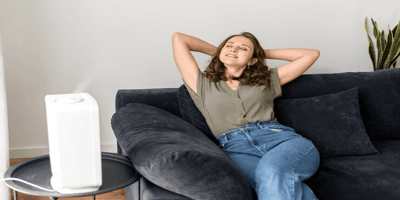Seasonal Allergy in Fall: Causes and Survival Guide
Many people discover that seasonal allergy in fall is their unwelcome friend as the crisp autumn air sets in. Often accompanied by sneezing, watery eyes, and continuous itching are the beauty of fall foliage, cooler temperatures, and comfortable inside activities. The season can be more of a struggle than a delight for those afflicted by common fall allergies.
Effective management of symptoms depends on knowledge of the causes of these allergies. You can prevent discomfort by knowing seasonal allergies in fall triggers, including pollen, mold spores, and dust mites, and acting early. In recent years, there has been a major reduction in indoor allergens, thanks in great part to technological developments, including air quality control devices. Sensibo and other temperature regulating devices can significantly help keep your living space allergy-free.
Let's now investigate the reasons behind these allergies and appropriate management strategies.
.jpg?width=800&height=400&name=photo_2024-09-20_18-01-42%20(1).jpg)
What Causes Seasonal Allergies in Fall?
The allergies that impact us change with the seasons as well. While spring is usually connected with blooming flowers and tree pollen, autumn allergies bring their own particular set of difficulties.
Pollen
Some weeds, particularly ragweed, spew pollen into the air even if autumn slows down trees and flowers. One of the most infamous offenders for fall allergies is ragweed pollen. Ragweed is difficult to avoid since it grows best in cooler temperatures, and its pollen can travel hundreds of miles. Just a tiny bit of ragweed pollen can set off sneezing episodes, itchy eyes, and a runny nose in those sensitive to seasonal allergies.
Mold Spores
Leaves make the ideal habitat for mold to flourish as they start to fall and gather on moist ground. Fall's moist and humid environment helps pollen and mold—especially mold spores—to flourish. Common triggers for autumn allergies are mold, which thrives in damp areas, including bathrooms, basements, and piles of fallen leaves. Mold spores are easily airborne and cause symptoms such as coughing, sneezing, and respiratory trouble when inhaled.
Dust Mites
People spend more time indoors, where dust mites become more of a concern as the temperature drops. These microscopic organisms, especially in bedding, carpets, and upholstered furniture, flourish in warm, humid surroundings. Turning up the heat inside generates the ideal environment for dust mite multiplication. Their presence is significant for those who already have allergic rhinitis since it significantly contributes to seasonal allergies.
The first step in managing seasonal allergy in fall is knowing these triggers. Nevertheless, what do we have to do practically to reduce symptoms? Let's examine some survival techniques now.
.jpg?width=800&height=400&name=photo_2024-09-20_18-00-45%20(1).jpg)
Practical Survival Guide for Fall Allergies
Managing seasonal allergies need not be a losing struggle. The right techniques can help you greatly lower allergens in your surroundings and stop flare-ups.
Maintain Clean Air Indoors
Keeping clean air in your house will help you fight indoor allergies the best. By catching seasonal allergens, including dust, pollen, and mold spores, air purifiers fitted with HEPA filters help to improve general air quality. Regular ventilation of your house is also crucial, particularly following cleaning or vacuuming, to help allergens avoid becoming trapped inside.
Regular Cleaning
Eliminating allergy symptoms depends on regular cleaning. Vacuum your carpets and rugs at least once a week, using moist towels to clean surfaces to trap dust, pollen, and mold. Regular hot water washing of your bedding also helps eradicate dust mites, which can accumulate over time.
Use Sensibo for Enhanced Air Quality
Sensibo is a clever way to control allergens and manage your house environment. The key for minimizing seasonal allergies, Sensibo guarantees your house stays at ideal air quality by controlling temperature. It also lets you instantly monitor air quality levels, so facilitating quick response when necessary.
Medication and Natural Remedies
Sometimes, symptoms still strike even with the best preventative measures. Commonly used over-the-counter antihistamines, nasal sprays, and decongestants to control allergic rhinitis are Natural remedies. Saline nasal rinses, herbal teas, and essential oils such as eucalyptus can help those looking for natural cures for itchy throats and congestion.
Regular cleaning, air quality control, and appropriate remedies, taken together, will help reduce the effect of seasonal allergies on daily life.
Lifestyle Changes to Minimize Fall Allergies
In addition to practical strategies, certain lifestyle changes can help you cope with fall allergies more effectively.
Allergen-Proofing Your Home
Start with little changes all around the house. Tightly seal your windows to keep pollen and mold spores out. Frequent hot water washing of your bedding will help to reduce allergens; thus, you might want to replace your carpets with hardwood or tile since they do not trap allergens as readily. Regular vacuuming of carpets is essential to reduce dust and pollen accumulation if you wish to keep them.
Outdoor Activity Precautions
Even if fall's pleasures include outdoor activities, they can expose you to significant amounts of mold and pollen. See the local pollen count before leaving, particularly for ragweed pollen. Should the count be high, wear protective eyewear or a mask to lower exposure—shower and change attire to eliminate any residual allergens from your body and hair when you return indoors.
Though basic, these lifestyle adjustments can significantly lower your exposure to seasonal allergens both inside and outside your house.
.jpg?width=800&height=400&name=allergies-flowers-pollen-exacerbation-allergies-person-sneezes-watery-eyes-spring-summer%20(1).jpg)
Sensibo’s Air Quality Features for Fall Allergy Relief
For those who are serious about controlling their allergies, investing in smart technology can make a world of difference. Sensibo offers several features that help you maintain a healthier indoor environment during allergy season.
Temperature Regulation
One of the key benefits of Sensibo is its ability to regulate temperature. Dust mites thrive in warm, humid environments, but with Sensibo’s precise temperature control, you can create an indoor space that is less hospitable to these allergens. Keeping the temperature cool helps minimize dust mite activity and makes your home more comfortable during seasonal allergy in fall.
Air Quality Monitoring
Sensibo’s advanced air quality monitoring feature provides real-time insights into the quality of the air inside your home. It tracks factors like humidity, particulate matter, and temperature, helping you make adjustments to prevent allergens from circulating indoors. In combination with air filters and regular cleaning, Sensibo can be an essential tool for keeping your home’s air free from pollen, mold, and other allergens.
By using technology like Sensibo, you can create a safer, allergy-friendly environment for yourself and your family. Its user-friendly features make managing seasonal allergens easier than ever, ensuring your indoor air stays fresh and clean.
Let’s Wrap-Up
Fall allergies can be a nuisance, but with the right strategies, they are manageable. From identifying common allergens like ragweed pollen, mold spores, and dust mites to making simple lifestyle changes and utilizing advanced technology like Sensibo, you can significantly reduce your symptoms. By understanding your triggers and actively managing your environment, you can enjoy the beauty of autumn without the constant sneezing and discomfort. Keep your air clean, stay prepared, and remember a proactive approach is key to surviving seasonal allergies in the fall.


































.jpg)
.png?height=200&name=image5%20(1).png)


.jpg?height=200&name=photo_2023-12-29_20-01-46%20(1).jpg)